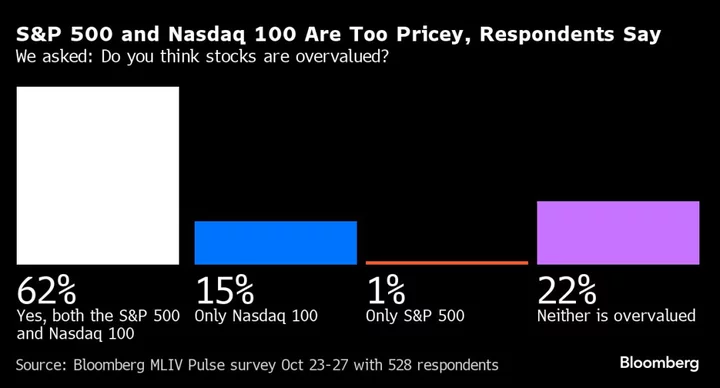The interest rate that neither spurs nor slows the US economy has at least doubled in the aftermath of the pandemic, handing investors a reason to be nervous about buying bonds or stocks, according to the latest Bloomberg Markets Live Pulse survey.
Some 85% of 528 respondents reckon the so-called real neutral rate — which strips out the effect of inflation — has risen to around 100 basis points or higher, from estimates of about 50 basis points before Covid struck.
Federal Reserve Chair Jerome Powell said in March that “honestly, we don’t know” where the neutral rate lies. But if the resilient US economy has pushed it above what has prevailed historically, that adds to the case for the central bank to keep monetary policy tighter for longer — crimping the value of stocks and bonds.
Both asset classes have been getting battered of late as investors have absorbed the prospect of an extended period of higher interest rates. Ten-year Treasury yields briefly eclipsed 5% last week for the first time since 2007, fueling concern over technology-stock valuations in particular. Meanwhile, both the S&P 500 Index and the tech-heavy Nasdaq 100 entered a correction.
For 10-year Treasuries, survey participants have little expectation the pressure will ease. The maturity will likely end the year yielding 5%, according to the median forecast of respondents. More than 60% of poll participants say that both the S&P 500 and the Nasdaq 100 are overvalued, while some 15% estimate that valuations are stretched only for technology stocks.
The Nasdaq 100 will decline by as much as 10% this quarter, according to 45% of respondents. A fifth say it will slump more than that. Earlier in the year, enthusiasm surrounding artificial intelligence spurred investors to overlook rising interest rates, propelling the Nasdaq 100 about 35% higher in the first three quarters of the year. It’s now on track for its third straight monthly decline, something it hasn’t done in more than a year. And by one calculation, the technology complex is still overvalued by 10% as of the close on Friday.
The poll’s findings gel with a report from Bloomberg Economics that concluded the real neutral rate will climb to as much as 2.7% in the 2030s. In turn, according to the study, 10-year Treasury yields could settle somewhere between 4.5% and 5%.
As they did in December 2019, Fed officials estimate a long-run funds rate of 2.5% while assuming inflation of 2%, implicitly projecting a neutral real rate of 50 basis points. The neutral rate may have risen because of a host of factors, on top of the economy’s strength: Baby boomers are retiring and spending down their nest eggs, diminishing the supply of savings; China’s appetite for Treasuries is waning; and widening government deficits are increasing competition for investment capital.
What’s more, uncertainty about the future in the wake of the pandemic has spurred consumers to spend now and save later — a phenomenon known as high time preference. Essentially, that means consumers will seek higher interest rates to invest and forgo current spending, pushing the neutral rate higher.
A narrow majority of survey respondents are pessimistic about the implications of higher Treasury yields. This group projects that if yields stay above 5% for a quarter or longer, they would cause a hard landing, a scenario where the Fed’s actions to tame inflation trigger a recession. Some 47% say the economy would take it in stride.
The topic of elevated yields is likely to come up during Powell’s press conference after the central bank’s Nov. 1 policy decision, when officials are widely expected to hold rates steady at the highest in more than two decades. Investors will watch to see whether Powell comments on the Fed’s comfort level with the recent surge in yields and what that implies for the prospect of a soft landing.
Against the backdrop of elevated Treasury yields and the Fed’s message of higher for longer, almost 60% of survey respondents said they anticipate the dollar will be a stronger a month from now.
The MLIV Pulse survey of Bloomberg News readers on the terminal and online is conducted weekly by Bloomberg’s Markets Live team, which also runs the MLIV blog. Ven Ram is a cross-asset strategist for Bloomberg’s Markets Live. The observations are his own and not intended as investment advice. To subscribe for more MLIV Pulse surveys, click here.

